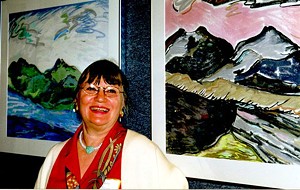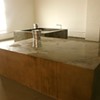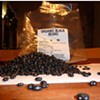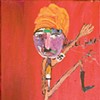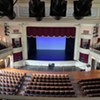Published July 22, 2009 at 9:50 a.m.
Claes Oldenburg first met Patty Mucha in an art-supply store in New York City. The two had separately gravitated there from the Midwest: he was a Swede who had recently obtained American citizenship; she was a Milwaukee girl of Polish extraction. They struck up a friendship that eventually led to marriage — 50 years ago — and a series of collaborations that helped make Oldenburg a household name.
Mucha, who now lives in Vermont, has written a yet-unpublished memoir, titled Clean Slate, about her experiences as Oldenburg’s first wife. She recreates the 10-year period, from 1960 to 1970, when she and Oldenburg made his famous soft sculptures, performed in “happenings” and, with a group of friends that included Andy Warhol, Jim Dine and Roy Lichtenstein, launched the Pop Art movement.
It was a heady time to be an artist. But being a wife proved not much different for Mucha than it had been for women before her: She lived in Oldenburg’s shadow and expended her artistic talent on sewing together his most famous pieces, including “Hamburger” and “Soft Switches.”
“It was really clear from the start that there was only room for one artist and he considered himself the artist,” Mucha says. “I very willingly accepted that because he was so powerful and wonderful as an artist. And then, after a while, I became part of it anyway.”
It wasn’t until long after their divorce, and her subsequent move to Barnet, that Mucha began to find her own artistic persona. She didn’t begin to paint again in earnest until the late 1980s, but when she did, she found a style all her own.
A retrospective of her work at St. Johnsbury’s Catamount Arts Center includes a self-portrait from 1959, the year she married Oldenburg, portraits of women from the 1980s, a series of erotica drawings on paper, landscapes, treatments of farm animals and interpretive flag paintings.
If you’re expecting Mucha’s work to be derivative of Oldenburg’s facetious sculptural statements on consumerism, you’ll be surprised, disappointed or both.
For one thing, she’s not primarily a sculptor; she prefers painting. And she’s not interested in abstraction, nor does she have a penchant for minimalism. Oldenburg’s purist interpretations of mass-produced objects hold no fascination for her. Where he re-created ordinary things such as an apple core, a clothespin and a section of a bike tire as gigantic exemplars of the Platonic ideal, Mucha paints representative tableaux and splashy scenes. From an aesthetic standpoint, at any rate, they appear to have had little in common.
The former Mrs. Oldenburg likes to infuse her paintings with emotion. Her landscapes tend to be seas of large, colorful brushstrokes, and her portraits of animals and people are also rendered with an almost overwhelming exuberance.
Ironically, the erotica drawings are restrained, even sterile in their anatomically correct geometries. A number of these pieces, including a drawing of two women pleasuring each other, and one of a penis and vulva, have been relegated to a closet in the exhibition space. Mucha complains, “The board thought they were too risqué. How tedious.” At the opening earlier this month, there was a line to get inside the closet.
Though her Pop Art period seems a lifetime ago, Mucha has found herself retracing her steps to New York lately. Oldenburg has a retrospective, too, this summer at the Whitney Museum of American Art, and Mucha plans to go, in part to see old friends — and herself, reflected in the funhouse mirror of film footage from the period. Whatever bitterness she may have felt after their divorce seems to have dissipated. Mucha appears to be at peace with her past, and with Oldenburg. In any case, her current focus is on the memoir.
“I ran into somebody who said, ‘Make sure you put the love and sex in it,’” Mucha confides. “I want it to be a book that you take to the beach in Southhampton and say, ‘Oh, this is what they did.’”
With any luck, she’ll recount their love making between the “meat” and the “bun” of the canvas “Hamburger.”
Want to see more?
“Patty Mucha: A Mini-Retrospective,” Catamount Arts Center, St. Johnsbury. Through July. Talk and slide show presentation, “Pop Art Revisited,” by Patty Mucha on Saturday, July 25, at 7:30 p.m. Info, 748-2600.
More By This Author
Speaking of Art, state Of The Arts
-

Q&A: Catching Up With the Champlain Valley Quilt Guild
Apr 10, 2024 -

Video: The Champlain Valley Quilt Guild Prepares for Its Biennial Quilt Show
Apr 4, 2024 -

Q&A: Meet a Family in Waterbury That Embraces Halloween Year-Round
Feb 14, 2024 -

Video: Goth Family in Waterbury: Sarah, Jay and Zarek Vogelsang-Card
Feb 8, 2024 -

Q&A: Art Entrepreneurs Tessa and Torrey Valyou Celebrate 15 Years of New Duds
Oct 11, 2023 - More »
Comments
Comments are closed.
From 2014-2020, Seven Days allowed readers to comment on all stories posted on our website. While we've appreciated the suggestions and insights, right now Seven Days is prioritizing our core mission — producing high-quality, responsible local journalism — over moderating online debates between readers.
To criticize, correct or praise our reporting, please send us a letter to the editor or send us a tip. We’ll check it out and report the results.
Online comments may return when we have better tech tools for managing them. Thanks for reading.



































